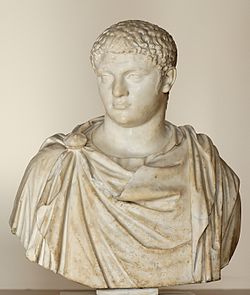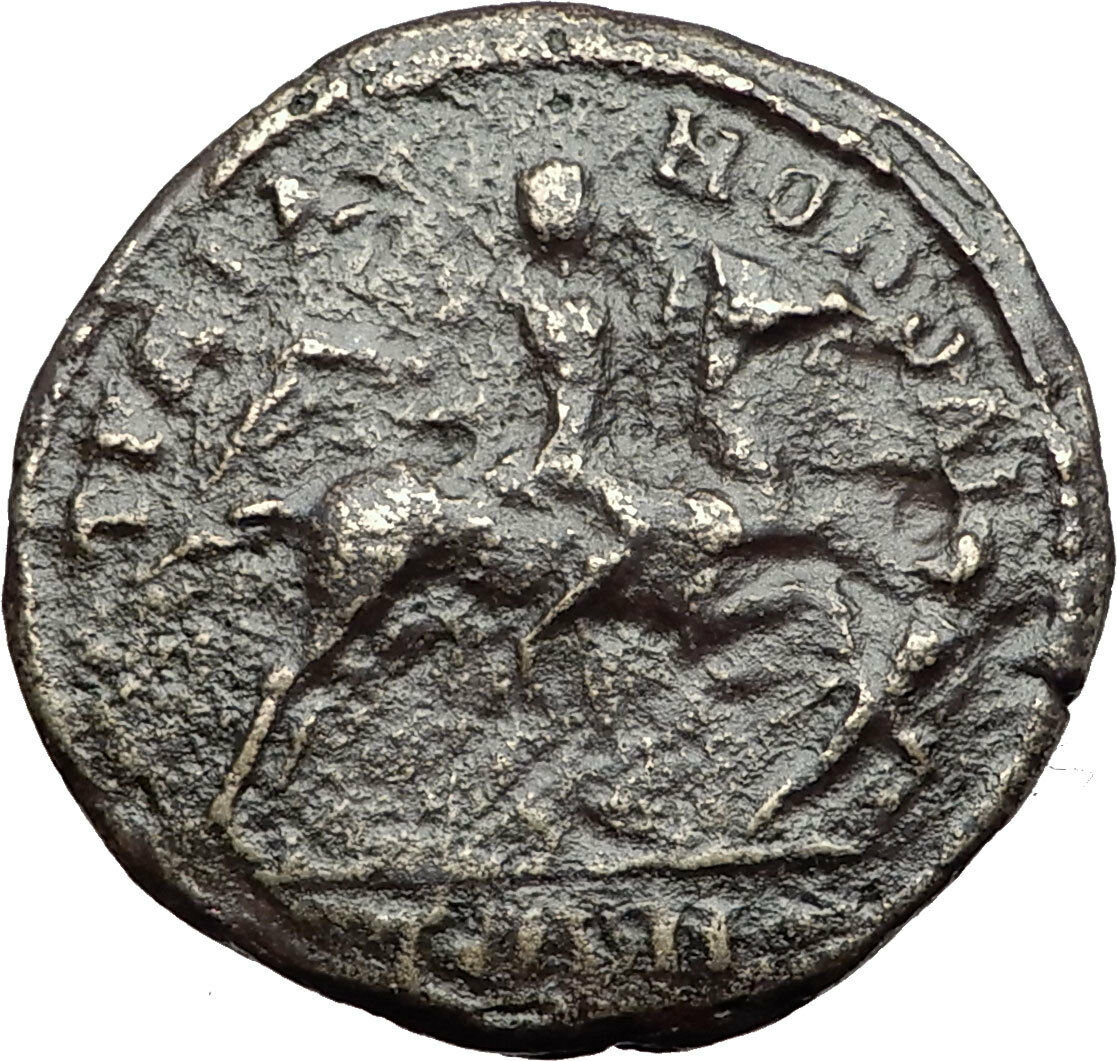|
Geta
– Roman Caesar: 198-209 A.D. –
Roman Emperor
: 209-211 A.D. ––
Bronze 20mm (3.88 grams) of
Pautalia
in
Thrace
Π CEΠTI ΓEΤΑC K, Bare-headed, draped and
cuirassed bust right.
ΠAVTAΛIΩTΝ,
Dionysus standing facing, holding thyrsos and
kantharos, panther
at his feet to left looking up at him.
You are bidding on the exact item pictured,
provided with a Certificate of Authenticity and Lifetime Guarantee of
Authenticity.
_with_Female_Head_-_Walters_482763_-_View_A.jpg/260px-Greek_-_Red-Figure_Kantharos_(Drinking_Vessel)_with_Female_Head_-_Walters_482763_-_View_A.jpg)
A
kantharos or cantharus is a type of
Greek pottery
used for drinking. It is
characterized by its high-swung handles which extend above the lip of the pot.
The kantharos is a cup used to hold
wine, possibly for drinking or for
ritual
use or
offerings
. The kantharos seems to be an
attribute of
Dionysos
, the god of wine, who was associated
with
vegetation
and
fertility
. It may not be a banquet-cup, but
rather a vessel used in pagan cult as a symbol of
rebirth or resurrection
, the
immortality
offered by wine, “removing in
moments of ecstasy the burden of self-consciousness and elevating man to the
rank of deity.”
In
Greek mythology
, a thyrsus or thyrsos
(Greek:
θύρσος
) was a staff of
giant fennel
(Ferula communis) covered
with ivy
vines and leaves, sometimes wound with
taeniae
and always topped with a
pine
cone
. These staffs were carried by
Dionysus
and his followers.
Euripides
wrote that
honey
dripped from the thyrsos staves that the
Bacchic
maenads
carried.The thyrsus was a sacred
instrument at religious rituals and
fêtes.
Symbolism
The thyrsus, associated with
Dionysus
(or Bacchus) and his followers, the
Satyrs
and
Maenads
, is a symbol of
prosperity
,
fertility
,
hedonism
, and pleasure/enjoyment in general. It
has been suggested that this was specifically a fertility
phallus
, with the fennel representing the shaft
of the penis and the pine cone representing the “seed” issuing forth. The
thyrsus was tossed in the Bacchic dance:
Pentheus: The thyrsus— in my right hand shall I hold it?
-
- Or thus am I more like a Bacchanal?
Dionysus: In thy right hand, and with thy right foot raise it”
Sometimes the thyrsus was displayed in conjunction with a
kantharos
wine cup, another symbol of Dionysus,
forming a male-and-female combination like that of the royal scepter and orb.
Literature
In the Iliad
,
Diomedes
, one of the leading warriors of the
Achaeans
, mentions the thyrsus while speaking
to
Glaucus
, one of the
Lycian
commanders in the
Trojan army, about
Lycurgus
, the king of
Scyros
:
He it was that/drove the nursing women who were in charge/of frenzied
Bacchus through the land of Nysa,/and they flung their thyrsi on the ground
as/murderous Lycurgus beat them with his ox-/goad. (Iliad, Book
VI.132-37)
The thyrsus is explicitly attributed to Dionysus in
Euripides
‘s play
The Bacchae
as part of the costume of the
Dionysian cult.
…To raise my Bacchic shout, and clothe all who respond/ In fawnskin
habits, and put my thyrsus in their hands–/ The weapon wreathed with
ivy-shoots…” Euripides also writes, “There’s a brute wildness in the
fennel-wands—Reverence it well.” (The Bacchae and Other Plays, trans.
by Philip Vellacott, Penguin, 1954.)
Socrates
writes in
Phaedo
:
I conceive that the founders of the mysteries had a real meaning and were
not mere triflers when they intimated in a figure long ago that he who
passes unsanctified and uninitiated into the world below will live in a
slough, but that he who arrives there after initiation and purification will
dwell with the gods. For “many,” as they say in the mysteries, “are the
thyrsus bearers, but few are the mystics,”–meaning, as I interpret the
words, the true philosophers.
In Part II of
Johann Wolfgang von Goethe
‘s
Faust
,
Mephistopheles
tries to catch a
Lamia
, only to find out that she is an
illusion:
Well, then, a tall one I will catch…/And now a thyrsus-pole I
snatch!/Only a pine-cone as its head. (7775-7777)
Sookie Stackhouse notes the thyrsus carried by the maenad in the 2nd book of
The Southern Vampire Mysteries
.
She idly waved the long wand with the tuft on the end. It was called a
thyrsis [sic];
I’d looked maenad up in the encyclopedia. Now I could die educated. (Harris,
Charlaine (2006-09-01). “Living Dead in Dallas: A Sookie Stackhouse Novel”}
Gallery
-
A Bacchant holding a thyrsus: Malice, by
William-Adolphe Bouguereau
, 1899
-
Roman relief showing a Maenad holding a thyrsus (Prado,
Madrid
).
-
Bacchus Triumphant (1882)
by
John Reinhard Weguelin
-
A Maenad uses her thrysos to ward off a Satyr,
Attic red-figure
kylix
, circa 480 BC
Dionysus
is the god of the
grape harvest, winemaking and wine, of ritual madness, fertility, theatre and
religious ecstasy in
Greek mythology
. Alcohol, especially
wine, played an important role in Greek
![2nd century Roman statue of Dionysus, after a Hellenistic model (ex-coll. Cardinal Richelieu, Louvre[1])](https://upload.wikimedia.org/wikipedia/commons/thumb/8/8a/Dionysos_Louvre_Ma87_n2.jpg/200px-Dionysos_Louvre_Ma87_n2.jpg)
culture
with Dionysus being an important reason for this life style. His name, thought
to be a theonym
in
Linear B
tablets as di-wo-nu-so (KH
Gq 5 inscription), shows that he may have been worshipped as early as c.
1500–1100 BC by
Mycenean Greeks
; other traces of the
Dionysian-type cult have been found in ancient
Minoan Crete
. His origins are uncertain, and
his cults took many forms; some are described by ancient sources as Thracian,
others as Greek. In some cults, he arrives from the east, as an Asiatic
foreigner; in others, from
Ethiopia
in the South. He is a god of
epiphany
, “the god that comes”, and his
“foreignness” as an arriving outsider-god may be inherent and essential to his
cults. He is a major, popular figure of
Greek mythology
and
religion
, and is included in some lists of the
twelve Olympians
. Dionysus was the last god to
be accepted into Mt. Olympus. He was the youngest and the only one to have a
mortal mother. His festivals were the driving force behind the development of
Greek theatre
. He is an example of a
dying god
.
The earliest cult images of Dionysus show a mature male, bearded and robed.
He holds a fennel
staff, tipped with a pine-cone and known
as a thyrsus
. Later images show him as a
beardless, sensuous, naked or half-naked androgynous youth: the literature
describes him as womanly or “man-womanish”. In its fully developed form, his
central cult imagery shows his triumphant, disorderly arrival or return, as if
from some place beyond the borders of the known and civilized. His procession
(thiasus)
is made up of wild female followers (maenads)
and bearded
satyrs
with
erect penises
. Some are armed with the
thyrsus, some dance or play music. The god himself is drawn in a chariot,
usually by exotic beasts such as lions or tigers, and is sometimes attended by a
bearded, drunken Silenus
. This procession is presumed to be the
cult model for the human followers of his
Dionysian Mysteries
. In his
Thracian
mysteries, he wears the bassaris
or
fox-skin, symbolizing a new life. Dionysus is represented by city
religions as the protector of those who do not belong to conventional society
and thus symbolizes everything which is chaotic, dangerous and unexpected,
everything which escapes human reason and which can only be attributed to the
unforeseeable action of the gods.
Also known as Bacchus, the name adopted by the
Romans
and the frenzy he induces, bakkheia.
His thyrsus is sometimes wound with ivy and dripping with honey. It is a
beneficent wand but also a weapon, and can be used to destroy those who oppose
his cult and the freedoms he represents. He is also called Eleutherios
(“the liberator”), whose wine, music and ecstatic dance frees his followers from
self-conscious fear and care, and subverts the oppressive restraints of the
powerful. Those who partake of his mysteries are possessed and empowered by the
god himself. His cult is also a “cult of the souls”; his maenads feed the dead
through blood-offerings, and he acts as a divine communicant between the living
and the dead.
In Greek mythology, he is presented as a son of
Zeus and the mortal
Semele
, thus semi-divine or
heroic: and as son of Zeus and
Persephone
or
Demeter
, thus both fully divine, part-chthonic
and possibly identical with
Iacchus
of the
Eleusinian Mysteries
. Some scholars believe
that Dionysus is a
syncretism
of a local Greek nature deity and a
more powerful god from
Thrace
or
Phrygia
such as
Sabazios
or
Zalmoxis
.
Kyustendil (Bulgarian:
Кюстендил, historically
Велбъжд, Velbazhd) is a town in the
far west of Bulgaria
, the capital of
Kyustendil Province
, with a population of
58,059 (2005 census). Kyustendil is situated in the southern part of the
Kyustendil Valley, 90 km southwest of
Sofia
. It was named after the medieval lord of
the surrounding region,
Constantine Dragaš
.
A Thracian
settlement was founded at the place of
the modern town in the
5th
-4th century BC and the
Romans
developed it into an important
stronghold, balneological resort and trade junction called Pautalia
in the 1st century AD.
The Hisarlaka fortress was built in the 4th century and the town was
mentioned under the
Slavic
name of Velbazhd (Велбъжд,
meaning “camel”)[1]
in a 1019 charter by the
Byzantine
Emperor
Basil II
. It became a major religious and
administrative centre.
Publius Septimius Geta (March
7, 189
–December
26, 211
), was a
Roman Emperor
co-ruling with his father
Septimius Severus
and his older brother
Caracalla
from 209 to his death.
Geta was the younger son of Septimius Severus by his second wife
Julia Domna
. Geta was born in
Rome, at a time when his father was only a provincial governor at the
service of emperor
Commodus
.
Geta was always in a place secondary to his older brother Lucius, the heir
known as Caracalla. Perhaps due to this, the relations between the two were
difficult from their early years. Conflicts were constant and often required the
mediation of their mother. To appease his youngest son, Septimius Severus gave
Geta the title of Augustus in 209. During the campaign against the
Britons of the early 3rd century, the imperial propaganda publicized a happy
family that shared the responsibilities of rule. Caracalla was his father’s
second in command, Julia Domna the trusted counsellor and Geta had
administrative and bureaucratic duties. Truth was that the rivalry and antipathy
between the brothers was far from being improved.
Joint Emperor
When Septimius Severus died in
Eboracum in the beginning of 211, Caracalla and Geta were proclaimed
joint emperors and returned to Rome.

Regardless, the shared throne was not a success: the brothers argued about
every decision, from law to political appointments. Later sources speculate
about the desire of the two of splitting the empire in two halves. By the end of
the year, the situation was unbearable. Caracalla tried to murder Geta during
the festival of
Saturnalia
without success. Later in December
he arranged a meeting with his brother in his mother’s apartments, and had him
murdered in her arms by
centurions
.
Following Geta’s assassination, Caracalla
damned his memoryy
and ordered his name to be
removed from all inscriptions. The now sole emperor also took the opportunity to
get rid of his political enemies, on the grounds of conspiracy with the
deceased. Cassius Dio
stated that around 20,000 persons
of both sexes were killed and/or proscribed during this time.
|





_with_Female_Head_-_Walters_482763_-_View_A.jpg/260px-Greek_-_Red-Figure_Kantharos_(Drinking_Vessel)_with_Female_Head_-_Walters_482763_-_View_A.jpg)

_-_Mailice_(1899).jpg/83px-William-Adolphe_Bouguereau_(1825-1905)_-_Mailice_(1899).jpg)
_04b.jpg/116px-Ménade_relieve_romano_(Museo_del_Prado)_04b.jpg)
.jpg/76px-John_Reinhard_Weguelin_–_Bacchus_Triumphant_(1882).jpg)

![2nd century Roman statue of Dionysus, after a Hellenistic model (ex-coll. Cardinal Richelieu, Louvre[1])](https://upload.wikimedia.org/wikipedia/commons/thumb/8/8a/Dionysos_Louvre_Ma87_n2.jpg/200px-Dionysos_Louvre_Ma87_n2.jpg)





